Part 22: New cylinders delivered, and assorted boiler work—February 2002
Progress has been steady, rather than spectacular during most of this year.
New cylinders, and frame work
The new cylinders have been received at Panorama, fully machined and ready for installation.
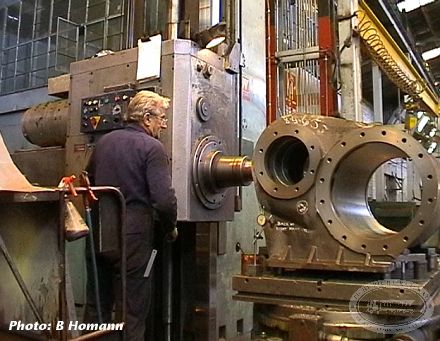
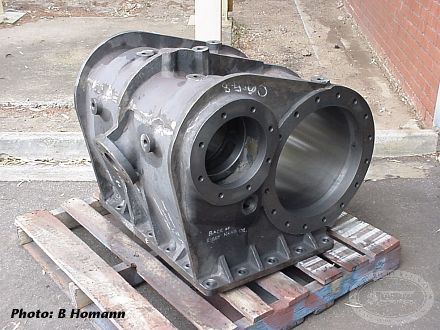
A great deal of effort has been expended on the fitting and fixing of the axle box horns and the spring compensating gear. This virtually un-noticeable task has required the location of the horns and compensating beam brackets, and reaming over a 100 1"+dia holes. This has been a combination of lugging a heavy magnetic base drill inside the frames for initial sizing by drill, and laborious hand turning of the reamer to finish off. These holes are now being filled with fitted rivets. These are a hammer press fit in the holes when cold. The ends are then heated up and riveted into counter sunk holes by two men wielding hammers. This has taken a bit of practice, and on only a few occasions so far have we been able to meet the standards of yesteryear where the riveting over was achieved in one heat. However, there are plenty more to do, so the skill level will improve.
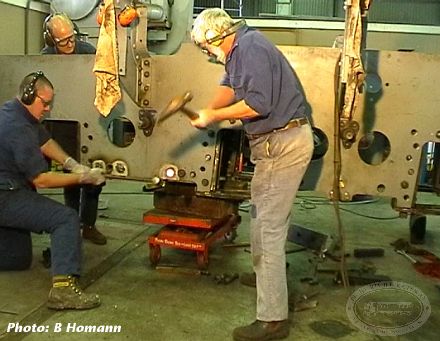
Brackets to hold up the running boards have simultaneously been fitted, this time by hot riveting. Once again there have been many holes to drill, with the mag base drill having to be set up sideways. In a few cases, for the ashpan door operating cylinder location bolts, the drill was upside down. Drilling was done in the fervent hope that the power did not go off.
The brand new ashpan has been fitted, and then removed to allow finishing of its doors, and to allow room for the afore mentioned drilling and reaming works.
Because of the need for access for drilling, riveting etc, it has been necessary to hold back the fitting of important looking items like cylinders. The hammering is difficult enough, without having to lean over great big castings.
It has been slow and demanding work, for which there is little to visually show.
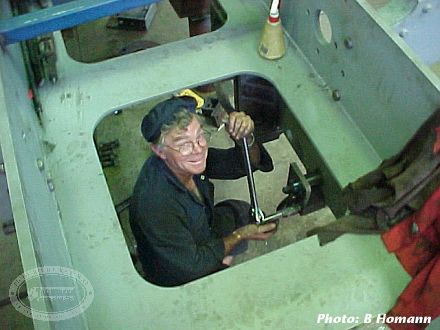
Work has commenced on some components in the motion and reversing gear. Even here, it has been slow work, with virtually every hole having to be rebushed. In some instances, this requires the component to be set up for boring the hole true, then a new bush produced and case hardened. Once this is done, the pin or bolt that goes in the hole generally has to be renewed and be heat treated. None are "off the shelf" items.
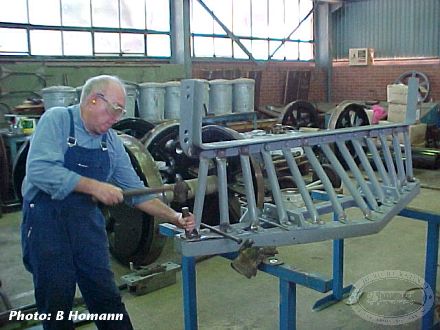
Boiler work at Mount Barker
The boiler has been the scene of continuing frustration. The firebox, in the region of the foundation ring, has fishbellied over the years such that it pushed the frames apart! One symptom of this was the crescent shape grooves worn into the frames by the wheels! Initially, we thought this frame movement was all due to lack of support and the bashing received as the boiler slipped from side to side during its many voyages to Alice Springs and back. Certainly the rivet marks in the old frame plates suggested that. However, it seems that slow creep of the boiler itself also provided unrelenting pressure.
Because the new frames are the size and shape they are meant to be, and because we do not want to repeat the problem of the wheels rubbing against the frames, it has been necessary to try and straighten the firebox. Initial calculations indicated that a squeezing force of 20 tons would be adequate to achieve the desired straightening effect. They were wrong! The first try did straighten the firebox, but only elastically, so it went back whence it came when the load was released. With the benefit of some hindsight, a finite element stress analysis was done which confirmed the "after first try gut feel" that 30 to 40 tons was going to be required.
While putting this sort of squeeze on the boiler seems all wrong, there is no alternative short of removing the firebox and starting over again. We would require a rich benefactor to enable the project to go that far. Work is in hand for the boiler squeezer MarkII.
There is, however, some positive progress, with the new longitudinal stays being fitted. Whilst doing this, a copper stay was noted as looking decidedly peculiar in its relationship with the plate it was screwed through. Consultation with the boiler inspector concluded with a decision to replace it, and possibly two others. Once this particular problem is resolved, the final piece of plate, the firebox tube nest will be ready for welding into place. A small portable boring machine has been made to finish some of the tube holes that had to be left undersize due to closeness to the weld line. This has been tested on the draw bar pin location below the cab floor where existing profile cut holes had to be trued up to take the draw bar pin bushings (new naturally!). This same device will be used to true up and align the location for the reversing shaft in the frames.
